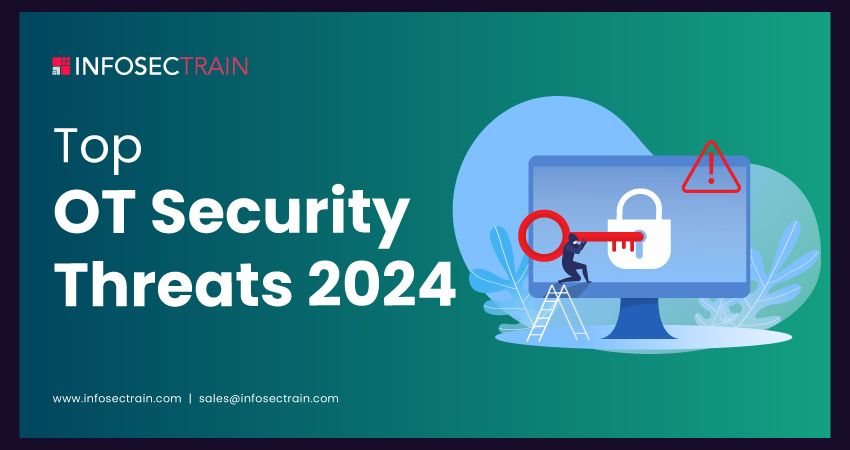Top OT Security Threats
Operational Technology (OT) serves as a vital component for numerous industries, providing the necessary support for critical infrastructure, manufacturing operations, and essential services. OT systems support all aspects of modern life, including power grids, water treatment plants, transportation and logistics, healthcare, manufacturing facilities, and telecommunication networks. As these systems become more interconnected and dependent on digital technologies, they also become more susceptible to various security threats. This article will discuss the main OT security threats that organizations and infrastructure operators must address to safeguard against potentially severe consequences.

Top OT Security Threats 2024
Industries are greatly concerned about the security threats of Operational Technology (OT). These threats can cause serious consequences such as personal harm, disruption of operations, monetary losses, data breaches, loss of intellectual property, environmental damage, etc. Some of the top OT security threats are listed below:
1. Inadequate Authentication and Authorization: Inadequate or nonexistent authentication and authorization control measures can allow unauthorized individuals to gain access to OT systems. This could result in data breaches and system manipulation, putting the integrity and safety of critical infrastructure at risk.
2. Malware and Ransomware: OT environments can be seriously threatened by malicious software like malware and ransomware. Ransomware attacks on OT systems can lead to interruptions and operational disruptions and potentially cause physical harm. These attacks have become well-known for locking down crucial systems unless a ransom is paid.
3. Social Engineering and Phishing: Social engineering techniques and phishing scams target employees with access to OT systems. Once these individuals are compromised, they unknowingly allow attackers to gain access to sensitive networks. This gives the attackers the ability to manipulate or cause damage to industrial processes.
4. Lack of Network Segmentation: Failure to segment OT networks from corporate IT networks allows attackers to move laterally within an organization’s infrastructure once they gain access.
5. Unpatched Systems: Unpatched systems are a common vulnerability in OT environments. Many OT systems depend on legacy software that might not get regular security updates. Failure to enforce security patches and upgrades leaves OT systems vulnerable to known exploits, making them an easy target for attackers.
6. Third-party Dependencies: Using third-party vendors for OT solutions may expose organizations to notable vulnerabilities, particularly when these vendors do not adhere to stringent security practices.
7. Supply Chain Vulnerabilities: The supply chain is often a vulnerable aspect of OT security. Attackers can compromise the supply chain by introducing harmful components or software during the manufacturing or maintenance process. This can have severe consequences for the security and reliability of OT systems.
8. Insider Threats: Insider threats, whether from someone with malicious intent or who is careless, can pose a significant risk to OT security. Employees with access to OT systems may intentionally sabotage operations or accidentally cause damage due to mistakes and misconfigurations.
9. Insecure Remote Access: Having remote access to OT systems can be important for maintenance purposes but can pose a significant risk if not appropriately secured. Attackers can exploit weak remote access solutions to gain access to OT networks.
10. Physical Attacks: When someone has physical access to OT systems, they can potentially tamper with, destroy, or manipulate essential components of critical infrastructure. Protecting against such attacks is challenging as physical access intruders can cause havoc.
In conclusion, it is crucial to prioritize the protection of OT systems against these threats. To ensure the security of their operations, organizations should create thorough strategies for protecting their OT systems, such as risk assessments, regular patch management, network segmentation, employee training, intrusion detection systems, and well-defined incident response plans.
Related blogs:
- What is Operational Technology (OT)?
- Key Components of OT: Empowering Industrial Control & Monitoring
- Roles and Responsibilities of OT Security Professionals
- How to Make a Career Transition to OT Security
- Fundamentals of OT/ICS Security Foundation
- OT/ICS Security Interview Questions
- How to Secure an OT Network?
- ICS Network Architecture and Protocols
OT/ICS Security Training with InfosecTrain
Join InfosecTrain‘s comprehensive OT/ICS Security Foundation training program, designed to equip candidates with a deep understanding of Operational Technology (OT). Participants will get insights into the significance of OT security, grasp the essential components of OT/ICS systems, and become well-versed in identifying common OT security threats and attack vectors targeting OT/ICS environments. Enroll today to fortify your knowledge in this critical field.




 1800-843-7890 (India)
1800-843-7890 (India) 
